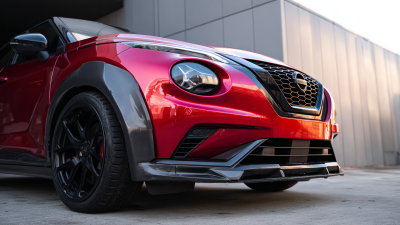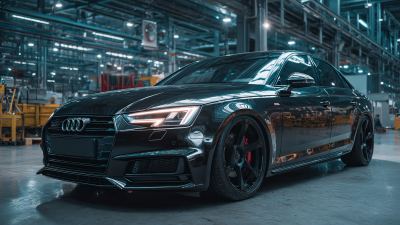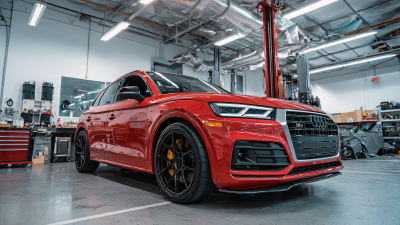
The Future of Automotive Safety: Innovations in Front Bumper Design
As the automotive industry continues to evolve, the emphasis on safety remains a top priority, particularly in front bumper design, which serves as the first line of defense in vehicle collisions. Innovations in this area are crucial, as traditional bumpers often fall short in providing adequate protection for both passengers and pedestrians. With increasing attention to sustainability and advanced materials, the evolution of front bumpers offers an opportunity to address longstanding problems, such as inadequate energy absorption and poor integration with advanced safety systems. This blog will explore the latest developments in front bumper technology, examining how cutting-edge designs not only enhance safety but also align with the broader goals of modern vehicle engineering. We will delve into the challenges faced by manufacturers and how new approaches can help create a more secure driving experience, paving the way for a future where automotive safety is paramount.

Innovative Materials in Front Bumper Design for Enhanced Safety
The automotive industry is witnessing a significant transformation in front bumper design, driven by the need for enhanced safety. One of the most notable innovations is the use of advanced materials that not only improve performance during impact but also contribute to vehicle efficiency. According to a report from the National Highway Traffic Safety Administration (NHTSA), strategic use of materials like high-strength steel and carbon fiber can reduce the weight of bumpers by up to 30%, while maintaining or even improving their protective capabilities.
For manufacturers, investing in innovative bumper designs can be a game-changer. Researchers estimate that vehicles equipped with modern bumper systems can lessen pedestrian injuries by nearly 40% in low-speed collisions. This not only boosts consumer safety but also aligns with the ongoing push for greener technologies in automotive design, as lighter vehicles typically consume less fuel.
Tip: When considering new vehicles, pay attention to the material of the front bumper. Opting for cars that utilize advanced composite materials can significantly enhance safety metrics. Additionally, look for models with bumpers designed to absorb impact better, as these can help mitigate damage in both low and high-speed accidents.
The Future of Automotive Safety: Innovations in Front Bumper Design
| Material Type | Weight (kg) | Impact Resistance (kN) | Cost per Unit ($) | Recyclability (%) |
|---|---|---|---|---|
| Polypropylene | 5.0 | 40 | 30 | 100 |
| Aluminum | 3.5 | 75 | 50 | 90 |
| Carbon Fiber | 2.0 | 100 | 200 | 30 |
| Steel | 8.0 | 50 | 40 | 85 |
| Thermoplastic Elastomers | 5.5 | 55 | 35 | 95 |
The Role of Active Safety Systems in Modern Bumper Technology
The evolution of automotive safety has reached an exciting juncture with the integration of active safety systems into modern bumper design. These systems are engineered to enhance vehicle protection and prevent collisions, transforming traditional bumpers from mere shock absorbers into sophisticated technological components. By incorporating sensors, cameras, and radar, active safety systems can detect potential hazards and initiate preventive actions, such as automatic braking or steering adjustments, before a collision occurs.
Moreover, the design of front bumpers is increasingly focused on energy absorption and vehicle aerodynamics. Today's bumpers are not only built to withstand impacts but are also seamlessly integrated with advanced safety features. For instance, adaptive headlights and pedestrian detection systems can be incorporated into bumper designs, improving visibility and reducing accidents. As automotive technology progresses, the collaboration between bumper manufacturers and safety system developers will be crucial in creating vehicles that are not only safer but also smarter on the road.

Design Trends in Front Bumpers: Balancing Aesthetics and Functionality
The design of front bumpers is undergoing a significant transformation as manufacturers seek to enhance both aesthetics and functionality. In recent years, the integration of advanced materials and technology has led to innovations that not only improve vehicle safety but also elevate visual appeal. According to a recent report by the Automotive Safety Council, modern front bumpers can absorb impact energy up to 15% more effectively than previous models, greatly reducing the risk of injury during collisions.
With the rise of pedestrian safety regulations, designers are creating bumpers that soften impact zones while maintaining sleek lines. The trend towards lightweight composite materials has also allowed for a more fluid and attractive design, without compromising strength. This dual focus on beauty and utility has garnered attention, as studies indicate vehicles with aesthetically pleasing bumpers are perceived as safer, increasing consumer confidence.
**Tips:** When considering vehicle purchases, look for models that feature high-impact absorbing bumpers. Additionally, check if the bumpers align with modern pedestrian safety standards, as these innovations not only protect passengers but also contribute to broader community safety. Remember, investing in a vehicle with advanced bumper design can ultimately save money on repairs and enhance overall safety.
The Future of Automotive Safety: Innovations in Front Bumper Design
Future Technologies: How Smart Bumpers Will Transform Automotive Safety
As the automotive industry rapidly evolves, the integration of smart technologies is set to revolutionize front bumper design, enhancing vehicle safety like never before. According to a recent report from the Insurance Institute for Highway Safety (IIHS), modern vehicles equipped with advanced safety features reduced front-end collisions by 30% compared to models from only a decade ago. This impressive statistic underscores the necessity for continuous innovation in bumper design, where smart bumpers equipped with sensors, cameras, and AI algorithms can communicate with other vehicles and infrastructure to anticipate and prevent accidents.
Additionally, these smart bumpers can adaptively absorb impact forces, minimizing damage during a collision. A study by the National Highway Traffic Safety Administration (NHTSA) found that innovations in impact-absorbing materials could decrease injuries in low-speed collisions by up to 40%. As manufacturers aim to meet increasingly stringent safety regulations, implementing these technologies not only enhances occupant protection but also improves pedestrian safety.
Tip: When selecting a new vehicle, consider models that feature smart bumpers and advanced safety technology, as these enhancements can significantly protect both you and those around you. Furthermore, staying informed about the latest innovations can help you make better purchasing decisions that prioritize safety.
Regulatory Changes Impacting Front Bumper Design and Safety Standards
The automotive industry is undergoing rapid transformation, particularly in the realm of safety standards. Regulatory changes have significantly impacted front bumper design in recent years, pushing manufacturers to prioritize pedestrian safety, as well as vehicle collision prevention. New guidelines require bumpers to absorb impacts more effectively, thereby reducing damage to pedestrians and minimizing repair costs in low-speed accidents. This shift not only enhances overall safety but also demands innovative engineering and materials.

When considering a vehicle purchase, it's essential to research how different models comply with the latest safety regulations. Pay close attention to the bumper design—features like crumple zones and energy-absorbing materials can make a noticeable difference in safety outcomes. Additionally, looking for vehicles that have undergone rigorous crash testing can provide insight into their real-world performance.
As manufacturers embrace these regulatory changes, we can expect to see advanced features in front bumper designs, such as integrated sensors and adaptive systems that respond to potential collisions. Keeping an eye on these innovations will not only inform your purchasing decisions but also help you understand the future direction of automotive safety.
Related Posts
-

Bumper Front Comparison Analysis Unveiling Performance and Durability Differences
-

Unmatched Quality in Audi Bodykits: Why Global Buyers Trust Made-in-China Solutions
-

Top Strategies for Maximizing Audi Parts Quality and Performance
-

5 Essential Tips for Choosing the Right Audi Bodikit for Your Vehicle
-

Global Excellence in Manufacturing with Chinese Pride Unveiling the Best Audi Rear Bumper for Buyers Worldwide
-

Top Strategies for Sourcing the Best Audi Parts in a Competitive Market



